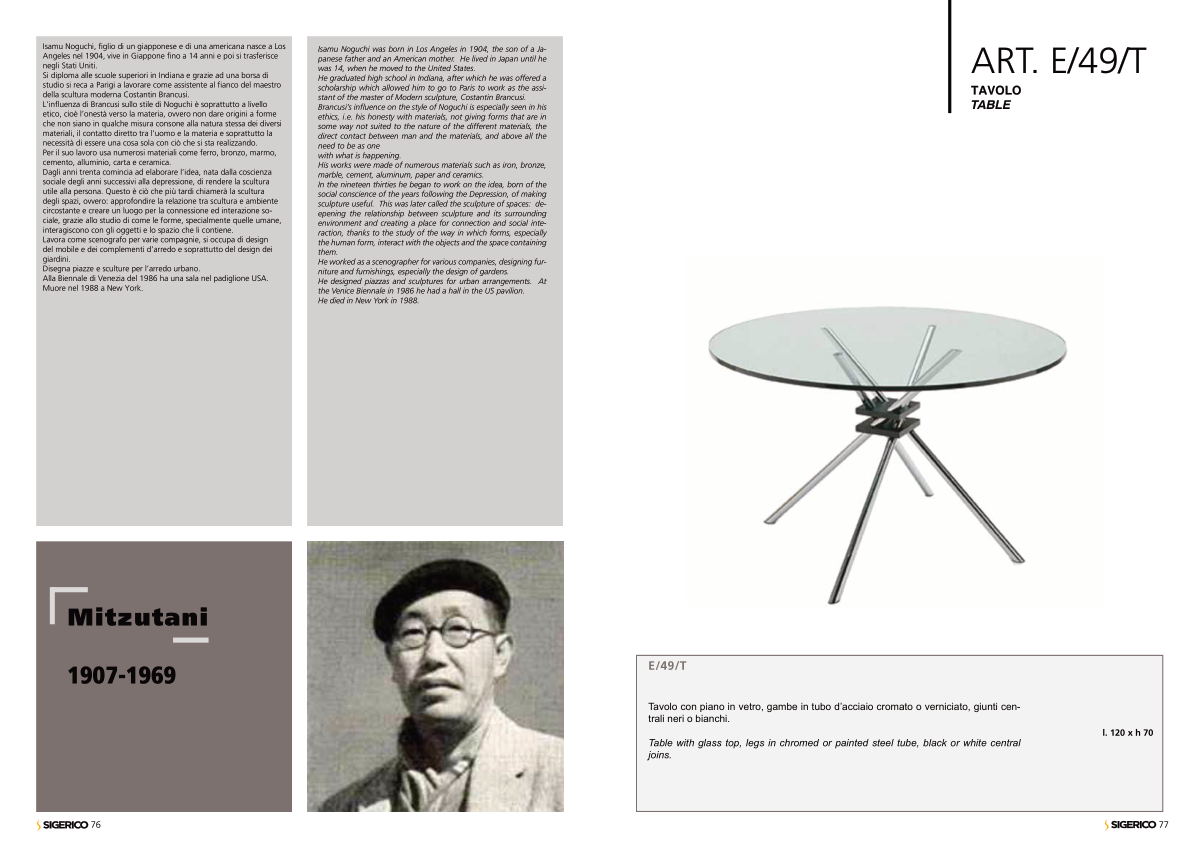Mitzutani
1907-1969
Isamu Noguchi, figlio di un giapponese e di una americana nasce a Los
Angeles nel 1904, vive in Giappone fino a 14 anni e poi si trasferisce
negli Stati Uniti.
Si diploma alle scuole superiori in Indiana e grazie ad una borsa di
studio si reca a Parigi a lavorare come assistente al fianco del maestro
della scultura moderna Costantin Brancusi.
L’influenza di Brancusi sullo stile di Noguchi è soprattutto a livello
etico, cioè l’onestà verso la materia, ovvero non dare origini a forme
che non siano in qualche misura consone alla natura stessa dei diversi
materiali, il contatto diretto tra l’uomo e la materia e soprattutto la
necessità di essere una cosa sola con ciò che si sta realizzando.
Per il suo lavoro usa numerosi materiali come ferro, bronzo, marmo,
cemento, alluminio, carta e ceramica.
Dagli anni trenta comincia ad elaborare l’idea, nata dalla coscienza
sociale degli anni successivi alla depressione, di rendere la scultura
utile alla persona. Questo è ciò che più tardi chiamerà la scultura
degli spazi, ovvero: approfondire la relazione tra scultura e ambiente
circostante e creare un luogo per la connessione ed interazione so-
ciale, grazie allo studio di come le forme, specialmente quelle umane,
interagiscono con gli oggetti e lo spazio che li contiene.
Lavora come scenografo per varie compagnie, si occupa di design
del mobile e dei complementi d’arredo e soprattutto del design dei
giardini.
Disegna piazze e sculture per l’arredo urbano.
Alla Biennale di Venezia del 1986 ha una sala nel padiglione USA.
Muore nel 1988 a New York.
Isamu Noguchi was born in Los Angeles in 1904, the son of a Ja-
panese father and an American mother. He lived in Japan until he
was 14, when he moved to the United States.
He graduated high school in Indiana, after which he was offered a
scholarship which allowed him to go to Paris to work as the assi-
stant of the master of Modern sculpture, Costantin Brancusi.
Brancusi’s influence on the style of Noguchi is especially seen in his
ethics, i.e. his honesty with materials, not giving forms that are in
some way not suited to the nature of the different materials, the
direct contact between man and the materials, and above all the
need to be as one
with what is happening.
His works were made of numerous materials such as iron, bronze,
marble, cement, aluminum, paper and ceramics.
In the nineteen thirties he began to work on the idea, born of the
social conscience of the years following the Depression, of making
sculpture useful. This was later called the sculpture of spaces: de-
epening the relationship between sculpture and its surrounding
environment and creating a place for connection and social inte-
raction, thanks to the study of the way in which forms, especially
the human form, interact with the objects and the space containing
them.
He worked as a scenographer for various companies, designing fur-
niture and furnishings, especially the design of gardens.
He designed piazzas and sculptures for urban arrangements. At
the Venice Biennale in 1986 he had a hall in the US pavilion.
He died in New York in 1988.
ART. E/49/T
TAVOLO
TABLE
Tavolo con piano in vetro, gambe in tubo d’acciaio cromato o verniciato, giunti cen-
trali neri o bianchi.
Table with glass top, legs in chromed or painted steel tube, black or white central
joins.
l. 120 x h 70
77
76
E/49/T


